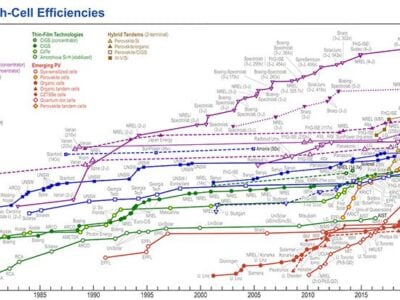
Book review: NANOCHIPS 2030 charts key chip technologies
The book’s self-declared aim is to present the key elements of an epoch in nanoelectronics that will follow the end of the nanometer roadmap.
The first two titles in the series – CHIPS 2020 volumes 1 and 2 – published in 2012 and 2015 respectively charted progress up until now. They foresaw the slowing of Moore’s Law and the rise of neural networks implemented in hardware. They also emphasized what is now a global ecological imperative to focus on energy efficiency rather than performance (see Book Review: CHIPS 2020 and Book review: CHIPS 2020 updates essential view of nanoelectronics).
The world has generally been spared the Internet outages that the second book warned of, but a global energy and resource consumption emergency is now clearly receiving more attention, especially amongst the young. The critical situation in this regard has partly, and temporarily, been alleviated by something else that the first two publications did not foresee – the Covid-19 pandemic – an oversight we can forgive.
For the latest text, NANOCHIPS 2030: On-chip AI for an efficient data-driven world to give its full title, Hoefflinger is joined by co-editor Boris Murmann a professor of electrical engineering at Stanford University.
It follows the same approach and general topical outline as the previous two books but nominally resets the timeline to 2030. The book examines the breadth of nanoelectronics by way of 30 chapters. As before, this inevitably means that some chapters are little more than a compendium of sources on the state-of-the-art while others are more detailed monographs on contributing authors’ subjects of expertise.
Next: sensors, logic, memory
Chapters covers such topics as the work of the International Roadmap for Devices and Systems (IDRS); lithography and CMOS; 3D integration and stacking for memory and logic; neural networks and domain-specific processing; high-performance computing; analog conversion; machine learning at the edge; MEMS and CMOS images sensors; neuromorphic computing, energy harvesting; augmented and virtual reality; quantum computing and automated driving.
Like previous books in the series this text is suitable for the student, researcher or recent graduate who wants to understand where the challenges lie for integrated circuits, and for experienced managers, investors and policy makers who welcome a book that ranges widely across the semiconductor waterfront.
The complete work is essentially an exercise is charting the flow of data along the sensing-memory-logic path but with little-to-no discussion of 5G or 6G communications or millimeter-wave or terahertz circuits. Inevitably references are historical and inevitably many are more than one or two years old. But in the fast-moving world of semiconductor devices, circuits and architectures, this does leave a sense of the gap between what is academically and commercially possible today and things that may be yet to come. In this annus horribilis that the world is enduring 2030 seems a long way off.
The final chapter provides an epilogue that looks forward to the thirties. The conclusion is that system and chip design must become more automated, modular and debug-friendly or risk becoming a showstopper for progress. One benchmark of that progress will be the “visual Turing test” where the observer will find it difficult or impossible to distinguish between reality and synthesized graphical images.
Therefore, progress a decade-and-more hence will include the continued blurring of the boundaries between the physical and virtual worlds and of the point where neuromorphic electronics ends and the human nervous system begins. If an increased cocooning of humans is the result, it may usefully allow for reduced energy consumption but it sounds more like the lockdown regimes used to fight the pandemic than it does progress.
Next: About the authors
Hoefflinger retired from a career in microelectronics in 2006, with the exception of his continued interest in writing and editing. His career included professorships in the United States and Germany as well as time working on semiconductors for Siemens and helping to found the Institute for Microelectronics Stuttgart (IMS) in 1985.
Professor Murmann received his PhD degree from the University of California, Berkeley, in 2003 and his research interests are in mixed-signal integrated circuit design, with a focus on sensor interfaces, data converters, and custom circuits for embedded machine learning.
The 592-page hardback book is published by Springer and comes with 374 illustrations with 296 in color. The book is priced at €93.59 in hardback before local taxes. but can be obtained at lower cost in ebook form; as low as €60.56 for a Kindle version on Amazon.
Related links and articles:
News articles:
Book review: CHIPS 2020 updates essential view of nanoelectronics
Internet blackouts by 2020, warns nanoelectronics book
Book Review: Linear Circuit Transfer Functions
Book review: ASML’s Architects
 If you enjoyed this article, you will like the following ones: don't miss them by subscribing to :
eeNews on Google News
If you enjoyed this article, you will like the following ones: don't miss them by subscribing to :
eeNews on Google News




